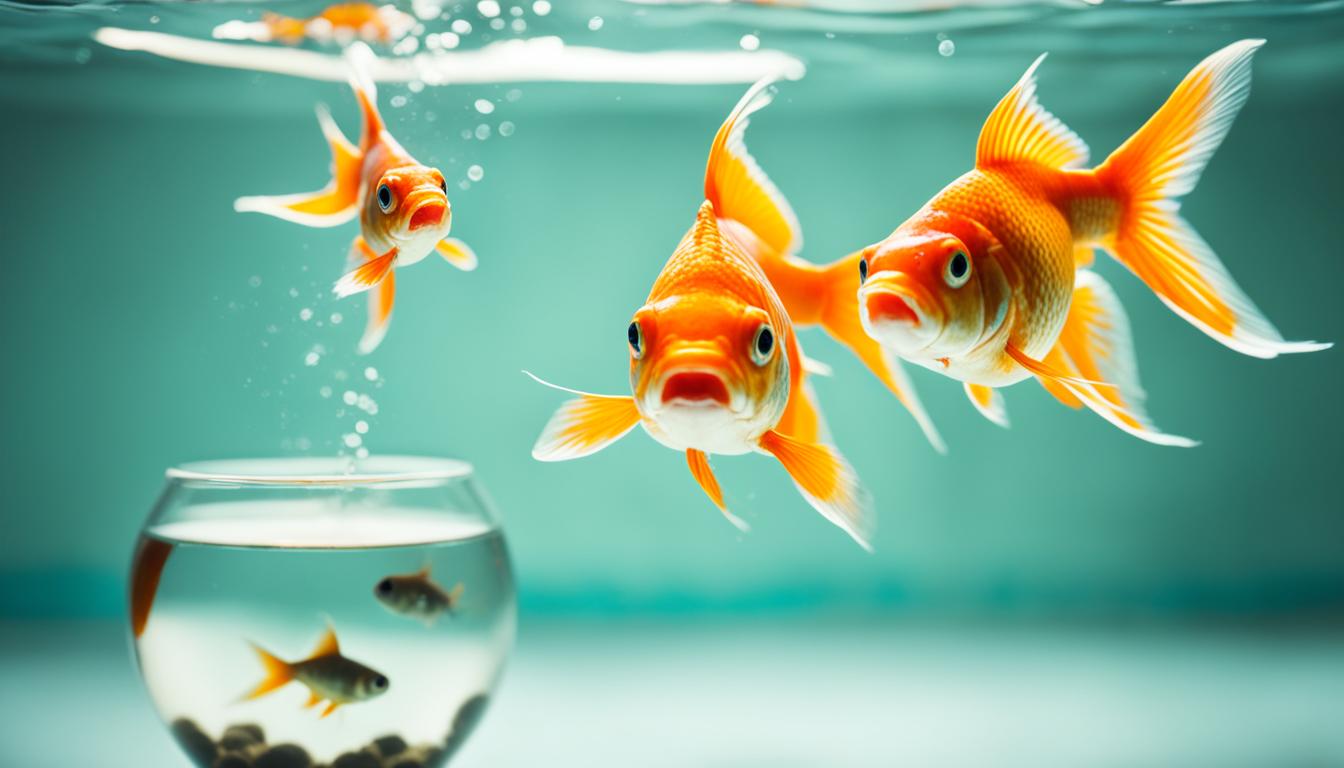Last Updated on 1 year by admin
Goldfish are intriguing creatures with fascinating behavior patterns. One common behavior that often captures the attention of fish owners is when goldfish chase each other. This peculiar behavior can leave many wondering about its underlying reasons and implications for their pet fish.
Today, we will delve into the world of goldfish behavior to understand why they exhibit this chasing behavior. By gaining insights into their social interactions and instincts, we can provide our fish with a comfortable and enriching environment.
Key Takeaways:
- Goldfish often chase each other as part of their natural mating ritual.
- Overcrowding and competition for resources can also lead to chasing behavior.
- Tank size, appropriate tank mates, and maintaining proper water quality can help reduce chasing and aggression.
- Observing and understanding goldfish behavior enhances the joy of owning these captivating aquatic pets.
- Creating a positive and stimulating environment can promote harmonious interactions among goldfish.
Goldfish Socialization and Taming
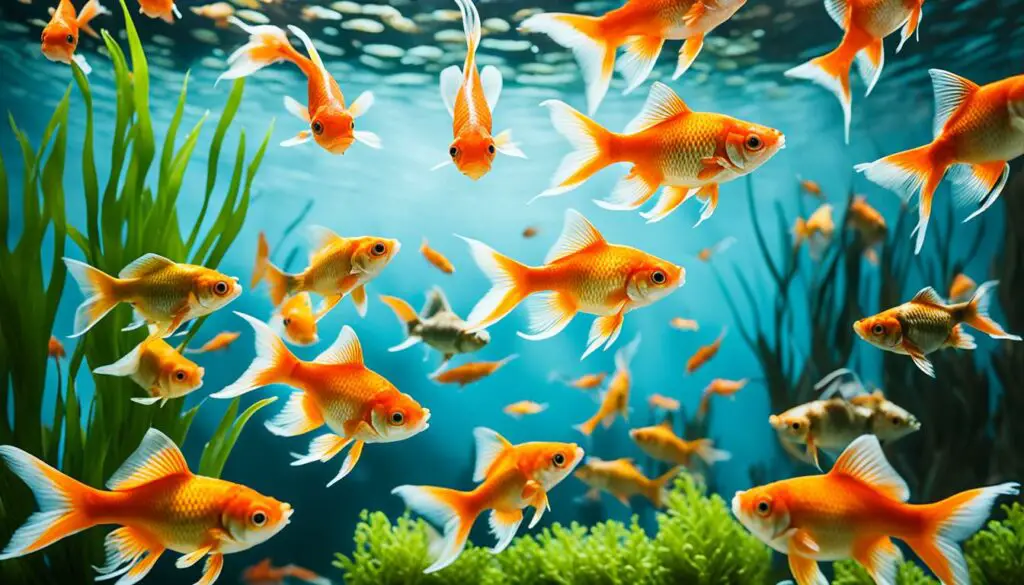
Goldfish are social animals that thrive in the presence of others. They have the remarkable ability to recognize their tank mates and even their keepers over time. Socialization is an essential aspect of goldfish behavior, as it allows them to form bonds and engage in various social interactions within their tank.
Taming goldfish involves creating a positive association between the fish and their keepers. By consistently providing them with food, interacting with them gently, and maintaining a calm environment, goldfish can develop trust and become more comfortable with human presence.
When goldfish are tamed, they become more responsive and actively seek interactions. They may swim towards their keepers, eagerly awaiting feeding time or showing curiosity during tank maintenance activities. Taming goldfish is a rewarding experience that deepens the bond between pet and owner.
To further enhance goldfish socialization and taming, it is important to provide a suitable tank environment. Consider the following factors:
- Tank Size: Goldfish need ample space to move, explore, and interact with other fish. A larger tank can accommodate more goldfish and provide them with room to establish territories, reducing potential conflicts.
- Compatible Tank Mates: Introducing compatible tank mates from the same species or other peaceful fish can encourage social behavior. However, it’s crucial to research and select appropriate tank mates based on their size, temperament, and environmental requirements.
- Enrichment: Adding decorations, plants, and hiding spots to the tank creates a stimulating environment that promotes natural behaviors and interactions. Goldfish enjoy exploring their surroundings and having places to retreat when needed.
- Dietary Variety: Providing a well-balanced diet that includes a mix of pellets, flakes, and fresh or frozen foods enriches their nutritional intake and encourages active feeding behaviors.
By implementing these strategies, goldfish enthusiasts can foster a harmonious tank environment and cultivate positive relationships with their fish. Remember, patience and consistency are key when it comes to socializing and taming goldfish!
Goldfish Socialization Tips
If you want to socialize your goldfish and strengthen your bond, here are some additional tips to consider:
- Observe and Interact: Spend time observing your goldfish’s behavior, noting their preferred swimming patterns and interactions with tank mates. Engage in quiet activities near the tank, such as reading or listening to music, to help them become accustomed to your presence.
- Hand-Feeding: Once your goldfish feels comfortable with your presence, you can start hand-feeding them. Use food items like bloodworms or brine shrimp for hand-feeding sessions, as it creates a positive association with your hand and presence.
- Establish Routine: Goldfish thrive on routine, so try to provide regular feeding, maintenance, and interaction times. Consistency helps them feel secure and can strengthen their bond with you as their caregiver.
- Minimize Stress: Avoid sudden changes in water conditions, temperature, or tank arrangement. Goldfish can become stressed easily, which may impact their social behavior and taming progress.
| Goldfish Socialization Benefits | Goldfish Taming Techniques |
|---|---|
| 1. Increased Sociability: Socialized goldfish show heightened interaction and communication with both other fish and their keepers. | 1. Consistent Interaction: Regularly spend time near the tank, observing and engaging with your goldfish to foster trust and familiarity. |
| 2. Decreased Stress Levels: Social interactions and positive associations reduce stress levels, leading to a healthier and happier goldfish. | 2. Gentle Touch: Gently stroke the goldfish’s side or back while hand-feeding to gradually accustom them to physical contact. |
| 3. Improved Overall Behavior: Taming goldfish can result in more well-behaved fish that readily respond to training cues and exhibit fewer aggressive tendencies. | 3. Positive Reinforcement: Reward good behavior with small food treats to reinforce positive associations and encourage desired behavior. |
Goldfish are known for their fascinating foraging behavior and unique eating habits. With their natural instinct to explore their surroundings, goldfish indulge in delightful foraging activities in their tank. They display a keen interest in digging through the substrate and nibbling on plants, creating an engaging spectacle to behold.
This foraging behavior is an integral part of goldfish’s grazing habits. By constantly searching for food, goldfish keep their metabolism active and fulfill their natural instincts. Their inquisitive nature drives them to sift through the tank, creating a captivating display of exploration and curiosity.
This instinctive behavior also contributes to the overall well-being of goldfish. It helps keep them mentally stimulated and physically active, promoting a healthy lifestyle. A varied diet that includes both commercial fish food and fresh vegetables further enhances their foraging experience.
Goldfish foraging behavior is not only an intriguing sight for hobbyists but also an essential aspect of their natural behavior. Providing an enriching environment with plenty of hiding spots, decorations, and live plants can stimulate their foraging instincts and create a visually appealing tank setup.
Observing goldfish engaging in their foraging activities can be a delightful experience for any aquarist. It allows us to appreciate their inquisitive nature and provides insights into their natural instincts. Creating a harmonious goldfish tank that encourages and supports their foraging behavior adds to the joy of pet ownership.
The Benefits of Goldfish Foraging Behavior
| Benefits | Explanation |
|---|---|
| Mental Stimulation | Foraging keeps goldfish mentally engaged, preventing boredom and promoting their overall well-being. |
| Physical Activity | Searching for food and exploring their environment provides goldfish with exercise, keeping them active and healthy. |
| Natural Instincts | Foraging behavior allows goldfish to fulfill their natural instincts, leading to a more fulfilling and contented life. |
| Enriching Environment | Creating a tank that supports their foraging instincts with hiding spots, decorations, and live plants adds visual appeal and enhances their overall welfare. |
Understanding Goldfish Chasing
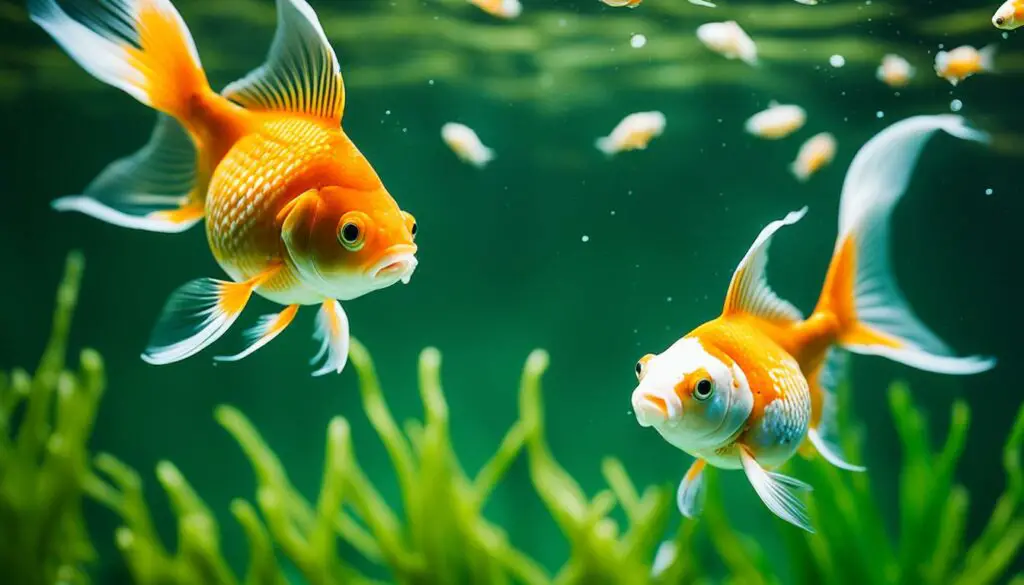
Goldfish chasing each other is a fascinating behavior that can be attributed to various factors, including mating rituals, territoriality, and competition for resources. Let’s delve into the details of this behavior and explore its significance.
During the mating season, male goldfish may chase females as part of their courtship ritual. This chasing behavior is a natural instinct that allows the males to demonstrate their interest and woo the females. It is accompanied by the release of pheromone chemicals into the water, which further signals their intentions.
Aside from mating, overcrowding and competition for resources can also trigger chasing behavior among goldfish. In cramped tanks or ponds with limited space, goldfish may chase each other to establish dominance or stake their claim to territory. This behavior is more likely to occur when there is a scarcity of food, shelter, or adequate swimming space.
It’s important to note that not all chasing behavior is aggressive or harmful. Goldfish may engage in playful chasing as a form of social interaction or exploration. It can help stimulate their natural instincts and provide mental and physical exercise.
To better understand goldfish chasing behavior, it’s essential to observe their body language, such as fin flaring, tail wagging, and lateral displays. These visual cues can provide insights into the goldfish’s intentions and emotions.
As responsible goldfish owners, it’s crucial to provide a suitable environment that mitigates chasing triggers. This includes providing a spacious tank with ample hiding spots and suitable tank mates that are compatible in size and temperament. Additionally, ensuring proper nutrition and maintaining optimal water quality can help reduce stress levels and minimize chasing behavior.
| Factors Influencing Goldfish Chasing | Preventive Measures |
|---|---|
| Mating behavior and courtship rituals | Provide a separate breeding tank to accommodate mating rituals. |
| Competition for resources | Ensure an adequate food supply and provide multiple feeding areas to alleviate competition. |
| Overcrowding and limited space | Provide a spacious tank with appropriate tank mates and plenty of swimming room. |
By understanding the underlying reasons behind goldfish chasing behavior and taking the necessary measures to create a harmonious environment, you can promote the well-being and social interactions of your beloved aquatic pets.
Goldfish Territoriality
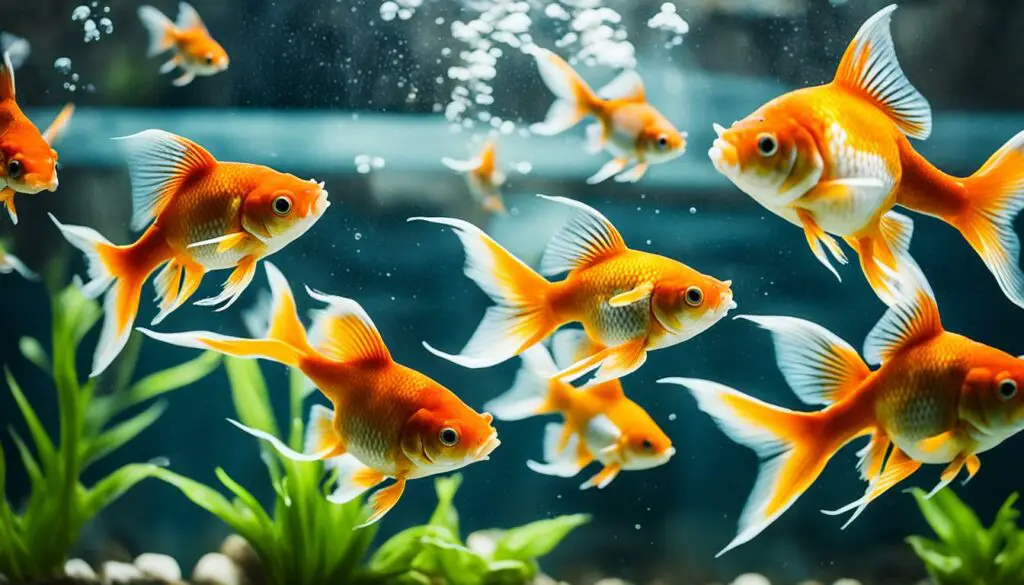
In cramped and overcrowded tanks, goldfish may exhibit territorial and aggressive behavior. They might chase each other to establish dominance or claim their territory. Providing enough space and suitable tank mates can help reduce aggression and territorial disputes.
Goldfish Aggression: Causes and Implications
Goldfish aggression is a common behavior observed in crowded tank environments. When space is limited, these beautiful aquatic creatures may engage in chasing behaviors to establish dominance or protect their territory. Understanding the causes and implications of goldfish aggression can help create a harmonious tank environment for your finned companions.
Goldfish are naturally territorial animals, instinctively staking out their own space in the tank. In the wild, they have vast areas to explore and claim as their own. However, when confined to a limited space, such as an overcrowded aquarium, their territorial instincts can become amplified.
Aggression and chasing behavior among goldfish can have serious ramifications. It can lead to physical harm, stress, and even death if left unchecked. Aggressive interactions can result in torn fins, injuries, and heightened stress levels for the fish involved.
Reducing Aggression and Territorial Disputes
To ensure a peaceful coexistence among goldfish, it is crucial to provide them with adequate space and suitable tank mates. Here are some strategies to help minimize aggression and territorial disputes:
- Optimal Tank Size: Provide a spacious tank that meets the recommended minimum sizes for each goldfish. As a general rule of thumb, aim for a minimum of 20 gallons per goldfish, with an additional 10 gallons per additional fish.
- Ensure Hiding Spots: Incorporate ample hiding spots, such as caves, tunnels, and plants, to allow goldfish to retreat and establish their territories within the tank.
- Select Peaceful Tank Mates: When adding tank mates to a goldfish aquarium, choose species known for their peaceful nature and compatibility with goldfish. Research and consult with fish experts to ensure a harmonious community.
- Provide Enrichment: Stimulate goldfish mentally and physically by including items like floating toys, live plants, and feeding puzzles. This can reduce boredom, divert aggression, and create a more enriching environment.
- Maintain Water Quality: Proper filtration, regular water changes, and monitoring water parameters are crucial for the overall health and well-being of goldfish. Clean water helps reduce stress levels, promoting more harmonious interactions.
Comparing Aggressive and Peaceful Goldfish Breeds
| Aggressive Goldfish Breeds | Peaceful Goldfish Breeds |
|---|---|
| Common Goldfish | Fantail Goldfish |
| Sarasa Comet Goldfish | Veiltail Goldfish |
| Shubunkin Goldfish | Bubble Eye Goldfish |
| Jikin Goldfish | Ranchu Goldfish |
“Creating a harmonious environment for goldfish involves understanding their territorial instincts and providing them with ample space to claim as their own.”
By implementing these strategies and understanding the nature of goldfish territoriality, you can create a peaceful and harmonious tank environment. These measures promote the well-being of your goldfish, reduce aggression, and ensure an enjoyable experience for both you and your aquatic companions.
Factors Influencing Goldfish Chasing
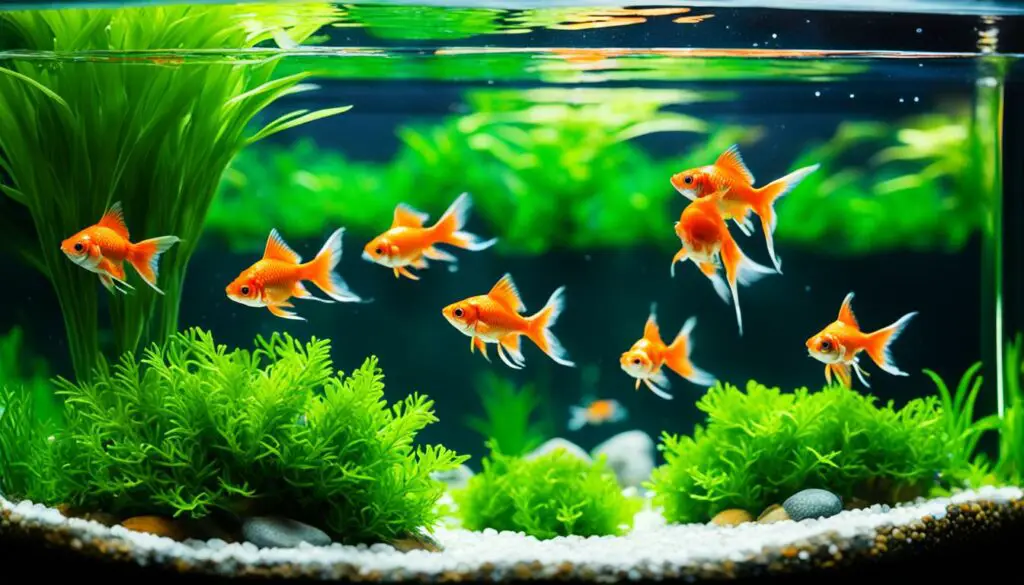
Goldfish chasing behavior can be influenced by various factors, including hunger, stress, and a desire to mate. Understanding these factors is crucial for creating a harmonious tank environment and reducing chasing incidents.
Goldfish Tank Mates
Having appropriate tank mates can play a significant role in minimizing goldfish chasing behavior. Compatible and peaceful tank mates provide companionship and reduce the likelihood of aggressive interactions. When selecting tank mates, consider the size, temperament, and dietary needs of each fish. Here is a list of goldfish-friendly tank mates:
- White Cloud Mountain Minnows
- Danios
- Loaches
- Corydoras Catfish
- Otocinclus Catfish
- Small Plecos
Introducing these compatible species to your goldfish tank can help create a peaceful and enjoyable environment for all inhabitants.
Stress Factors
Stress can contribute to goldfish chasing behavior. Identifying and addressing sources of stress is essential for promoting a calmer tank environment. Here are some common stress factors that can provoke chasing behavior:
- Inadequate tank size: Goldfish require spacious tanks to swim freely and establish their territories. Overcrowding can lead to stress and territorial conflicts.
- Poor water quality: Ammonia, nitrite, and nitrate buildup can harm goldfish and induce stress. Regular water testing and maintenance are vital for maintaining a healthy aquarium.
- Incompatible water parameters: Goldfish prefer cooler water temperatures than some other fish species. Ensure the water temperature, pH level, and hardness are suitable for goldfish.
- Insufficient hiding spots: Goldfish appreciate having hiding spots and places to explore. Providing caves, plants, and decorations can help reduce stress and aggression.
By addressing these stress factors, you can create a peaceful and stress-free environment that minimizes goldfish chasing behavior.
In summary, understanding the factors that influence goldfish chasing behavior is crucial for maintaining a harmonious tank environment. By carefully selecting compatible tank mates and addressing stress factors, you can create a peaceful and enjoyable home for your goldfish.
Curious Goldfish: Hovering at the Tank’s Surface
Goldfish are known for their active swimming behavior, exploring every nook and cranny of their tank. However, you may have noticed that sometimes they gather near the surface, seemingly curious about something. There can be a few reasons for this fascinating behavior.
One possible explanation is that goldfish associate the surface with feeding time. They have learned that when their keepers approach the tank, it’s often a sign that food will be provided. As intelligent creatures, goldfish eagerly gather at the surface in anticipation of a meal.
Goldfish are opportunistic feeders and can get excited when they sense food is near. They might even start splashing around or nudging each other as they compete for the food. It’s their way of showing enthusiasm!
Another reason goldfish hover near the surface is related to their oxygen needs. As with other fish, goldfish rely on dissolved oxygen in the water to breathe. If the oxygen levels in the tank become depleted, goldfish may exhibit this behavior as they strive to access more oxygen.
If you notice your goldfish frequently gasping for air at the surface, it could be a sign of low oxygen levels or poor water quality. This can be caused by factors such as overstocking the tank with too many fish, inadequate filtration, or lacking aeration. It’s crucial to address these issues promptly to ensure the well-being of your goldfish.
To maintain optimal oxygen levels in your goldfish tank, consider the following tips:
- Ensure proper filtration and aeration to promote water circulation and oxygen exchange.
- Avoid overcrowding the tank, as it can lead to increased waste production and oxygen depletion.
- Perform regular water tests to monitor oxygen levels and address any imbalances.
By following these practices, you can create a healthy and stimulating environment for your goldfish, reducing the likelihood of them gasping for air at the surface.
| Oxygen Level | Goldfish Behavior |
|---|---|
| Adequate | Goldfish exhibit active swimming and explore different depths of the tank. |
| Decreased | Goldfish may gather near the tank surface, anticipating feeding time or seeking more oxygen. |
| Low | Goldfish frequently gasp for air at the surface, indicating a need for immediate action to improve oxygen levels. |
Remember that goldfish hovering at the surface can signify both excitement and potential oxygen-related concerns. By understanding their behavior and taking appropriate measures to address any underlying issues, you can ensure the well-being of your curious goldfish companions.
Creating a Harmonious Goldfish Tank
To promote a harmonious tank environment for your goldfish, it is crucial to consider their tank size and the compatibility of their tank mates. Proper space and suitable companionship play a significant role in reducing aggression and chasing behavior.
Tank Size:
Goldfish are active and social creatures that require sufficient space to swim and thrive. Providing an adequate tank size is essential for their well-being. The general rule of thumb is to allocate a minimum of 20 gallons of water per goldfish. This size allows them to exercise, explore, and exhibit their natural behaviors more comfortably.
For example, if you have one goldfish, a 20-gallon tank would be suitable. If you plan to keep additional goldfish, it’s recommended to add an extra 10 gallons of water per fish. This additional space will ensure that each goldfish has ample room to swim, establish territory, and reduce the likelihood of aggressive interactions.
Tank Mate Compatibility:
Choosing the right tank mates for your goldfish is crucial to maintain harmony within the tank. When selecting companions, consider both size compatibility and temperament. Avoid pairing goldfish with species that may harass or outcompete them for resources.
Some suitable tank mates for goldfish include:
- Other Goldfish: As social animals, goldfish generally get along well with their own kind. Choose goldfish of similar size and temperament to avoid conflicts.
- White Cloud Mountain Minnows: These small, peaceful fish can coexist harmoniously with goldfish.
- Bristlenose Plecos: These bottom-dwelling fish can help keep the tank clean by eating algae, and their peaceful nature makes them compatible tank mates.
Remember, it’s important to research and understand the specific needs and behaviors of potential tank mates to ensure compatibility. Introducing new fish gradually and closely monitoring their interactions will help maintain a peaceful and harmonious goldfish tank environment.
Creating a Positive Goldfish Environment
Goldfish benefit from a well-enriched environment that provides mental and physical stimulation. By incorporating various elements into their tank setup, you can create a space that promotes their overall well-being and reduces boredom and aggressive tendencies.
Tank Decorations
Adding suitable tank decorations not only enhances the aesthetic appeal but also creates hiding spots and areas for exploration. Natural-looking ornaments, such as driftwood or rock formations, can mimic their natural habitat and provide opportunities for goldfish to explore and interact with their environment. Make sure to select decorations that are safe for aquarium use and do not have sharp edges that may harm your fish.
Live Plants
Introducing live plants into the tank not only adds visual appeal but also offers numerous benefits. Plants provide shelter, oxygenate the water, and create more natural browsing opportunities for goldfish. Some suitable plant options for goldfish tanks include Java Fern, Anubias, and Hornwort. Ensure that the chosen plants are compatible with the tank conditions and goldfish species.
Water Quality Monitoring
Regular monitoring of water quality is crucial to maintaining a healthy goldfish environment. Test the water parameters regularly, including ammonia, nitrite, nitrate levels, and pH, to ensure they remain within the appropriate range. Proper filtration, regular water changes, and removing any uneaten food or waste will help maintain optimal water quality.
Varied Diet
Providing a varied diet is essential for goldfish health and stimulation. In addition to high-quality commercial fish food, consider including fresh or frozen foods such as brine shrimp, bloodworms, or peas. These additional food options provide nutritional variety and mimic the goldfish’s natural foraging behavior. Be mindful of portion sizes to avoid overfeeding and maintain water quality.
Creating a positive goldfish environment through enrichment and stimulation is key to ensuring the well-being and happiness of your aquatic pets. By implementing diverse tank decorations, live plants, monitoring water quality, and providing a varied diet, you can help create a fulfilling and engaging environment for your goldfish.
Observing and Enjoying Goldfish Behavior
Spending time observing and understanding goldfish behavior can be a rewarding experience for pet owners. By learning their unique behaviors and cues, you can better appreciate their social interactions and individual personalities. It also allows you to detect any potential issues or changes in behavior that might require attention.
Goldfish are fascinating aquatic creatures with a range of behaviors that can captivate any observer. Whether it’s their graceful swimming, playful interactions, or quirky habits, there’s always something new to discover when watching these pets.
One interesting behavior to observe is how goldfish interact with each other. You may notice that some fish are more dominant or shy, and you can observe the social hierarchy within the tank. Understanding these dynamics can help you provide the right environment and tank mates for a harmonious community.
Signs of Healthy Behavior
When watching your goldfish, look out for signs of overall health and well-being. Here are some behaviors that indicate a healthy goldfish:
- Active swimming: A healthy goldfish will swim energetically throughout the tank, exploring its surroundings.
- Balanced feeding habits: Goldfish should exhibit a healthy appetite and display regular feeding behavior.
- Clear and bright eyes: The eyes should be clear with no cloudiness or redness, indicating good health.
- Healthy fins and scales: Check for any signs of damage, discoloration, or abnormalities in the fins and scales.
- Responsive to stimuli: Goldfish should react to external stimuli by showing curiosity or interest.
Observing goldfish behavior is not only entertaining but can also help you identify any potential issues early on. Changes in behavior, such as lethargy, loss of appetite, or unusual aggression, could indicate stress or health problems. The earlier you notice these changes, the sooner you can take action and provide the necessary care.
Enhancing the Goldfish Watching Experience
To make the most out of your goldfish-watching sessions, consider these tips:
- Create a comfortable viewing space: Set up a cozy corner near the tank where you can relax and observe your fish undisturbed.
- Set a regular observation time: Establish a routine so that you can observe your goldfish during their peak activity periods.
- Learn about different goldfish breeds: Each breed has its own unique behaviors and characteristics, adding variety and interest to your watching experience.
- Keep a behavioral journal: Take notes on any interesting or unusual behaviors you witness, allowing you to track patterns and changes over time.
- Join a goldfish community: Engage with other goldfish enthusiasts online or in local fishkeeping clubs to share experiences and learn from each other.
Remember, observing and enjoying goldfish behavior is not just about entertainment—it can also deepen your connection with these beautiful creatures and ensure their well-being. So, take some time every day to sit back, relax, and watch them swim in their mesmerizing aquatic world.
Conclusion
Goldfish behavior is a fascinating aspect of owning these captivating aquatic pets. One common behavior that captivates many goldfish owners is chasing each other. This behavior can serve various purposes, including mating, territoriality, and competition for resources.
To ensure a harmonious goldfish community, it is crucial to create a suitable tank environment. Providing adequate space for each goldfish, with a minimum recommended tank size of 20 gallons for one fish, can help reduce aggression and chasing behavior. Proper care and nutrition are equally important, as they contribute to the overall well-being and behavior of goldfish.
By understanding and appreciating goldfish behavior, owners can deepen their connection with these beautiful creatures. Observing their unique social interactions and individual personalities adds to the joy of keeping goldfish as pets. Enjoy the mesmerizing world of goldfish and provide them with the care they need for a happy and fulfilling life.
FAQ
Why do goldfish chase each other?
Goldfish chasing behavior can have various meanings, including mating, establishing dominance, or competing for resources.
Can goldfish recognize each other?
Yes, goldfish are social animals that can recognize each other and form bonds within their tank.
What is the normal behavior for goldfish?
Goldfish have a natural instinct to forage for food, explore their surroundings, and dig in the substrate of the tank.
Do goldfish chase each other during mating?
Yes, goldfish may chase each other as part of their courtship ritual during the mating season.
Why do goldfish exhibit aggressive behavior?
Goldfish may exhibit aggression due to overcrowding, competition for resources, or the need to establish dominance.
What factors can influence goldfish chasing behavior?
Hunger, stress, the desire to mate, and the presence of suitable tank mates can all influence goldfish chasing behavior.
Why do goldfish hover near the tank’s surface?
Goldfish may gather near the top of the tank in anticipation of feeding time or if the oxygen levels in the water are low.
How much space do goldfish need in a tank?
General recommendations suggest a minimum tank size of 20 gallons for one goldfish, with an additional 10 gallons per additional fish.
How can I create a positive environment for my goldfish?
Providing a well-enriched environment with suitable tank decorations, hiding spots, live plants, and a varied diet can create a positive goldfish environment.
Is it important to observe goldfish behavior?
Yes, spending time observing and understanding goldfish behavior can help you better appreciate their social interactions, individual personalities, and detect any potential issues.
Source Links
- https://thegoldfishtank.com/goldfish-info/biology/decoding-goldfish-behavior/
- https://animals.mom.com/one-fantail-goldfish-chase-other-7751.html
- https://www.tropicalfishkeeping.com/threads/my-goldfish-are-exhibiting-strange-behavior.26234/

